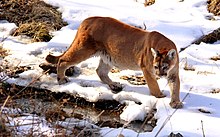
Back أسد جبال أمريكي شمالي Arabic Wasol (Puma concolor couguar) AVK Puma concolor couguar Spanish Puma concolor couguar Basque شیر کوهی آمریکای شمالی Persian Puma d'Amérique du Nord French פומה צפון-אמריקאית HE Puma nord-american Interlingua Puma concolor couguar Italian Puma concolor couguar Portuguese
| North American cougar | |
|---|---|

| |
| A cougar at Wildlife Prairie Park in Illinois | |
| Scientific classification | |
| Domain: | Eukaryota |
| Kingdom: | Animalia |
| Phylum: | Chordata |
| Class: | Mammalia |
| Order: | Carnivora |
| Suborder: | Feliformia |
| Family: | Felidae |
| Subfamily: | Felinae |
| Genus: | Puma |
| Species: | |
| Subspecies: | P. c. couguar[1]
|
| Trinomial name | |
| Puma concolor couguar[1] (Kerr, 1792)
| |
| Synonyms | |
| |
The North American cougar (Puma concolor couguar) is a cougar subspecies in North America. It is the biggest cat in North America (North American jaguars are fairly small).[4][5] And the second largest cat in the New World.[6] It was once common in eastern North America and is still prevalent in the western half of the continent. This subspecies includes populations in western Canada, the western United States, Florida, Mexico and Central America, and possibly South America northwest of the Andes Mountains.[7] It thus includes the extirpated eastern cougar and extant Florida panther populations.
- ^ Wozencraft, W. C. (2005). "Subspecies Puma concolor couguar". In Wilson, D. E.; Reeder, D. M. (eds.). Mammal Species of the World: A Taxonomic and Geographic Reference (3rd ed.). Johns Hopkins University Press. pp. 544–545. ISBN 978-0-8018-8221-0. OCLC 62265494.
- ^ "Puma concolor". explorer.natureserve.org.
Canada: N5, United States: N5
- ^ "Puma concolor browni". explorer.natureserve.org.
- ^ Barrett, J. (1998). Cougar. Blackbirch Press. ISBN 1567112587.
- ^ Rodrigo Nuanaez; Brian Miller; Fred Lindzey (2000). "Food habits of jaguars and pumas in Jalisco, Mexico". Journal of Zoology. 252 (3): 373–379. doi:10.1111/j.1469-7998.2000.tb00632.x. Retrieved 2006-08-08.
- ^ "Cougars". www.rollinghillszoo.org. Retrieved 2024-12-18.
- ^ Kitchener, A. C.; Breitenmoser-Würsten, C.; Eizirik, E.; Gentry, A.; Werdelin, L.; Wilting, A.; Yamaguchi, N.; Abramov, A. V.; Christiansen, P.; Driscoll, C.; Duckworth, J. W.; Johnson, W.; Luo, S.-J.; Meijaard, E.; O’Donoghue, P.; Sanderson, J.; Seymour, K.; Bruford, M.; Groves, C.; Hoffmann, M.; Nowell, K.; Timmons, Z.; Tobe, S. (2017). "A revised taxonomy of the Felidae: The final report of the Cat Classification Task Force of the IUCN Cat Specialist Group" (PDF). Cat News (Special Issue 11): 33–34.

